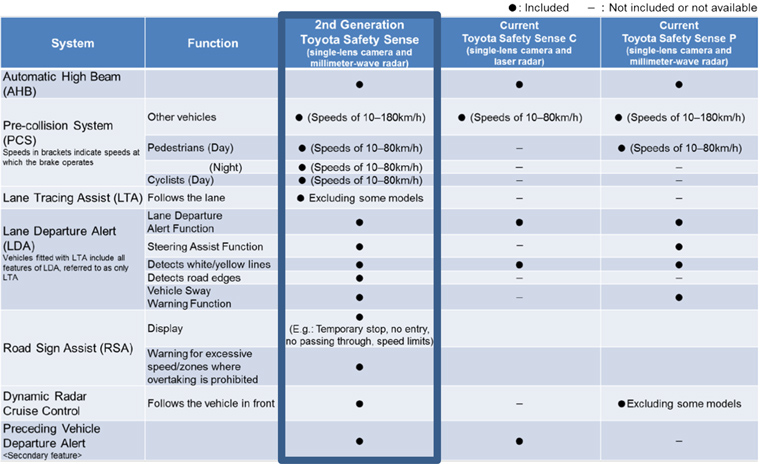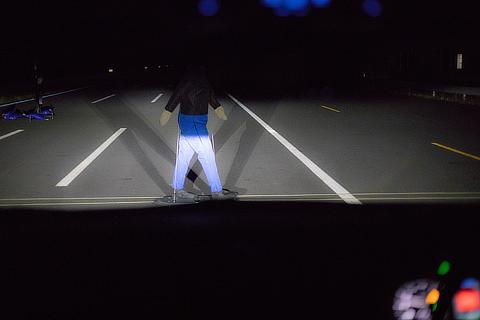Nov. 29, 2017
Toyota to Roll Out 2nd Generation Toyota Safety Sense Active Safety Packages from 2018

- Broadened scope of protection from severe accidents
- Additional advanced driving support functions
- Completion of rollout of 1st generation Toyota Safety Sense in almost all passenger cars in Japan, North America, and Europe
Toyota City, Japan, November 29, 2017―Toyota Motor Corporation (Toyota) will further contribute to accident reduction by progressively rolling out the second-generation Toyota Safety Sense―enhanced from the set of active safety packages first introduced in 2015―in its lineup from 2018.
Toyota Safety Sense is a set of active safety packages developed to reduce accidents guided by the concept of supporting drivers under the assumption that they will drive safely, and at the same time, mitigating damage should an accident occur. It comprises several functions, and its key features include the following:
- Pre-Collision System (PCS), which helps prevent and mitigate collisions with vehicles and pedestrians ahead
- Lane Departure Alert (LDA), which helps prevent vehicles from departing from their lanes
- Automatic High Beam (AHB), which helps ensure optimal forward visibility during nighttime driving
The second-generation Toyota Safety Sense being rolled out in 2018 will continue to utilize the single-lens camera and millimeter-wave radar currently used in Toyota Safety Sense P. It will be further enhanced with the following to prevent accidents and reduce the number of deaths and injuries from traffic accidents, and ease driver burden:
- Expansion of the scope of hazard detection, and improving functionality such as through improvements to the performance of the camera and radar
- Utilization of the advanced driving support feature Lane Tracing Assist (LTA)*1
- Reduction of the size of the unit to improve ease of installation
- Expanded scope of hazard detection and improved functionality
- Adding nighttime pedestrians and cyclists to the scope of hazards detected by PCS
- The current system is unable to detect nighttime pedestrians and cyclists. Adding these to the scope further broadens protection from causes of severe accidents.
(Nighttime) Pre-Collision System (PCS) for pedestrian detection
-
-

- (Daytime) Pre-Collision System (PCS) for cyclist detection
-
-
-

- (Daytime) Pre-Collision System (PCS) for pedestrian detection
-
- Road Sign Assist (RSA)
- Key road signs are read by the camera and displayed in the instrument panel.
- This feature supports even safer driving by helping to reduce the possibility of overlooking speed limits and traffic rules, such as stop signs, no entry signs, and no overtaking signs.
- Advanced driving support features
- Lane Tracing Assist (LTA) has been newly adopted to achieve such aims as easing driver burden and improving convenience.
- It keeps the vehicle in the center of a lane by assisting the driver in steering control when using Dynamic Radar Cruise Control. By accruing features such as Dynamic Radar Cruise Control, driver burden can be reduced in locations such as expressways, allowing drivers to drive with greater ease.
- LTA also comes with Lane Departure Alert (LDA). With the ability to recognize shoulders on straight roads without white lane markings, it gives alerts when deviating off roads, and assists in regaining track.
The second-generation Toyota Safety Sense will be progressively rolled out mainly in Japan, North America, and Europe, commencing with new models being launched at the start of 2018. Toyota is looking into rolling it out in other regions once confirming the usage environment in each region.
The rollout (either as a standard or optional configuration) of the first-generation Toyota Safety Sense in almost all passenger cars in Japan, North America, and Europe has recently been completed. Already, a total of five million vehicles worldwide are fitted with Toyota Safety Sense. In actual traffic conditions, effects of accident reduction*2 can be seen, such as an approximately 50 percent reduction in rear-end collisions and approximately 90 percent in combination with the Intelligent Clearance Sonar (ICS).
To develop a safe transportation society, it is necessary to conduct safety-related activities based on the following three pillars: 1) vehicle-based initiatives that lead to the manufacture of truly safe vehicles by incorporating a cycle of activities including accident surveys, analysis of accident causes, and development and commercialization of countermeasure technologies; 2) human-based initiatives such as educational programs for drivers and children; and 3) traffic environment-based initiatives including Intelligent Transport Systems (ITS) measures.
Besides expanding the adoption of active safety technologies, such as introducing the second-generation Toyota Safety Sense, Toyota is increasing opportunities for understanding Toyota Safety Sense and ICS to promote Support Toyota programs with the aim of enhancing customer safety and assurance. To contribute to its ultimate goal of the elimination of traffic fatalities and injuries, Toyota will continue its three-pillar approach in efforts to address people, cars, and the traffic environment.
- Note
- Features and performance may differ depending on the model.
*1Excludes some models
*2 The accident incidence rate is calculated by dividing the number of accidents by the number of vehicles in operation (converted from the number of vehicles sold based on the timing of sale).
-
- Subject vehicle series
- Prius
-
- Survey period
- December 2015-December 2016
-
- Survey subjects
- approximately 247,000 vehicles, of which approximately 84,000 were equipped with Toyota Safety Sense P, and approximately 121,000 were equipped with Toyota Safety Sense P and ICS































